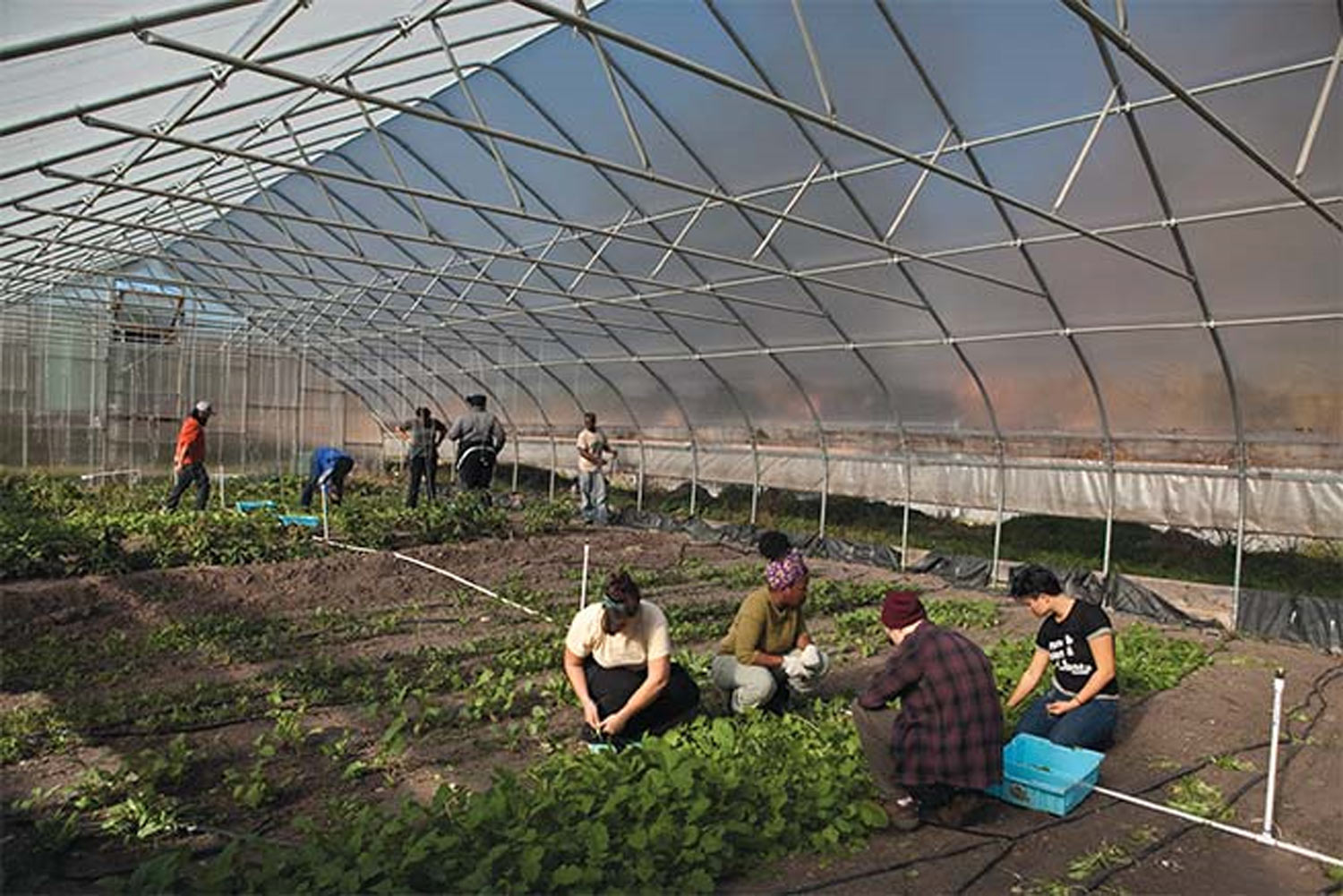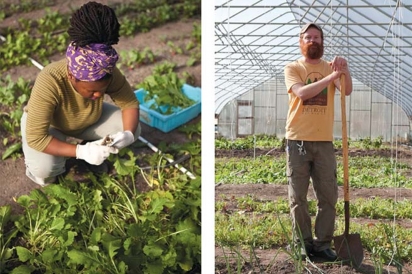How Michigan Farmers Grow in the Winter
Michigan's growing season is frustratingly short. But at the Royal Oak Farmers Market, “We’re a booming market all year round,” says Robin Richardson, the market’s manager of event planning. “You can come to the market on any given Saturday and buy a tomato.”
That’s because many of her vendors practice season extension. And one way to do that in Michigan is hoophouses. Also known as high tunnels, these unheated, plastic-walled, passive-solar enclosures allow plants to be started earlier—and later—than the outdoor season allows.
“They’re like cars—you can choose all kinds of options for them,” says Adam Montri, hoophouse outreach specialist at Michigan State University’s Department of Horticulture. He has 17,000 square feet of hoophouse on his farm, Ten Hens Farm in Bath. “It allows us to grow and harvest year-round without additional heat.”
At Hilltop Greenhouse and Farms outside Ann Arbor, owners Denise and Ken Prielipp had 52,000 square feet of greenhouse space sitting idle each year after the prime flower-selling season was over. They asked themselves, “How do we best utilize this space to maximize the investment we put in?” Now, Ken’s self-designed moveable boxes are used inside the greenhouse in the off-season, planted in succession so cool-weather products are available all winter. “We don’t get as cold as fast, and we can hold more heat,” Denise says. “I grow all winter.” Crops include lettuces, bok choy, carrots, radishes and many varieties of greens. In spring the boxes give way to greenhouse flower production.
Urban farmers in Detroit have also taken to hoophouses, including Keep Growing Detroit, the Greening of Detroit, and Earthworks, the farm at the Capuchin Soup Kitchen. The Capuchins’ farm manager, Patrick Crouch, says Earthworks’ 34- by 96-foot hoophouse near Mt. Elliott Cemetery is “completely off the grid.” The structure adds about four weeks on either side of the growing season, he says. In mid-February, “It starts getting warm enough in here, in the soil, for seeds to germinate.” Sowing begins again in late August and continues into early October. “What we’re doing is collecting heat during the day in the soil and it’s radiating back at night.”
The structure’s plastic sides are hand-cranked to open or close as needed. Rainwater collects in gutters along the walls, running into two tanks partially sunk into the ground. A solar cell powers a pump that pushes the water into an above-ground tank from which it irrigates the hoophouse. Grants from the Erb Foundation and the Ford Fund paid for the system.
In mid-October, young plants in the hoophouse included peppers, kale, radishes, lettuce and even ginger, which is sold at market in a young stage before it develops its familiar tough skin. “We try to expose people to a number of things,” such as Japanese Hakurei turnips, which are eaten raw. “It’s delicious and it grows well in the winter,” Crouch says. “You find you have to expand what you’re willing to eat if you want to eat off a hoophouse.”
Produce grown by the Capuchins goes to volunteers, a weekly market stand and the soup kitchen. “We serve salad every single day at the soup kitchen,” says Crouch, who has been with the Capuchins for 12 years. Planting is done in succession for continuous supply.
"There’s a period of time when growth slows down, but you can plan for that time. Since we’ve had the hoophouse, we’ve been able to harvest every single week.”
Not surprisingly, late January and early February are leanest. “At that time it may just be spinach, but it’s still fresh food,” he says. “Hoophouses are just one part of our overall plan for how to have food in the winter.”
Since the main hoophouse came online five years ago, Crouch says Earthworks produces three times the food it did previously. Heavily dependent on volunteers, it provides a sheltered environment, even in bad weather. “Before, we didn’t have a lot for volunteers to do from mid-November to early March,” he says. “A lot of times we’d lose a lot of dedicated volunteers.”
Hoophouse use has been growing in Michigan, thanks to a program that loans farmers up to $15,000 at zero interest for construction. These Hoophouses for Health loans are paid back within five years when farmers accept vouchers from qualified families at farmers’ markets or sell to the Michigan Farm to School program. MSU is one of three partnering organizations working with funding from the Kellogg Foundation.
The program has the twin goals of addressing hunger and boosting the state’s economic development. “We created a program that went after both of those,” MSU’s Montri says. “We’re basically using that same money to work twice.”
Crouch, one of two employees who work the farm for the Capuchins, has a hoophouse at home. He cautions that they are labor-intensive. “It’s a lot of work to have to open and close the vents daily as needed,” he says. Pest management can also be an issue. “Things that are a small problem out in the open can become a big problem,” he says. “It definitely requires more work and more planning. I have to think before I leave for work: Do I have to vent it this morning? And going on vacation in spring can be dicey.”
Still, it’s worth it. “I don’t think I could get through a Michigan winter without having a hoophouse to play in,” he says.






